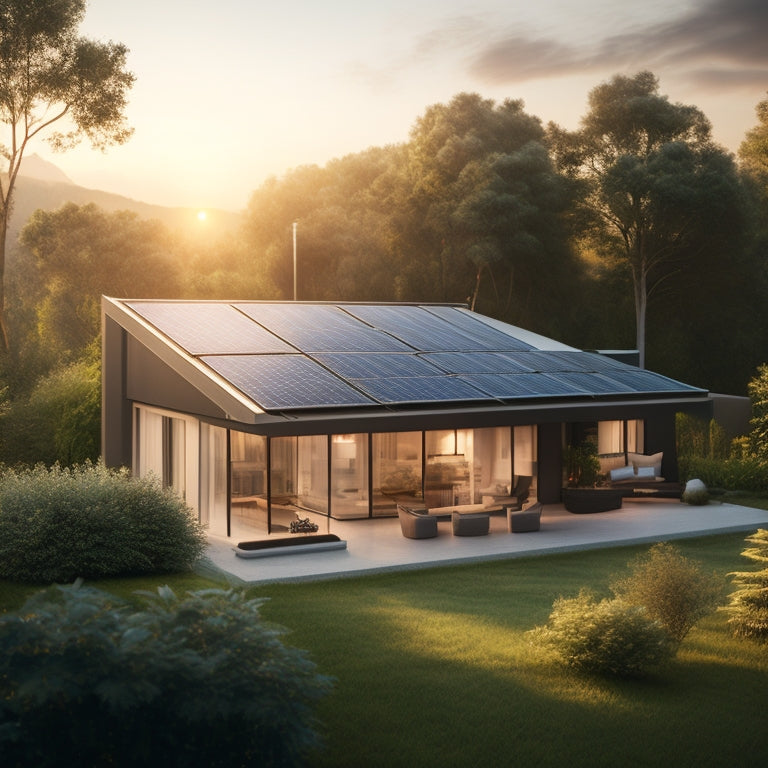
10 Steps to Home Energy Independence With Batteries
Share
You're taking a significant step towards breaking free from grid reliance by pursuing home energy independence with batteries, a goal that requires careful planning and execution to guarantee a seamless and efficient shift. Start by evaluating your energy needs to determine the required battery size, then choose the right battery type based on factors like cost, maintenance, and discharge rates. Next, select a compatible inverter and determine your backup power needs, plan your system configuration, and confirm safe and code-compliant installation. As you progress, you'll need to monitor and control your system, optimize energy harvesting and storage, and prepare for grid outages and emergencies, and by following these steps, you'll reveal the full potential of battery-powered energy independence.
Key Takeaways
- Assess daily energy consumption to accurately size batteries and optimize energy production.
- Choose the right battery type (lithium-ion or lead-acid) based on cost, lifespan, and maintenance needs.
- Select a compatible inverter that ensures seamless integration with the battery bank and optimizes energy production.
- Determine backup power needs by identifying essential appliances and their power requirements during outages.
- Plan a safe and code-compliant installation with a licensed electrician to ensure a reliable and efficient system.
Assess Your Energy Needs
Before you commence your expedition to home energy independence with batteries, it's essential to evaluate your energy needs. You must determine your daily energy consumption to guarantee you're installing a battery system that meets your power requirements.
Evaluating your energy needs involves monitoring your energy usage patterns, including the peak hours of consumption and the overall power efficiency of your appliances.
Consider local climate conditions and evaluate available space for solar panel installation and energy storage systems to maximize your energy output. By doing so, you'll be able to identify areas where you can optimize energy consumption, reducing your reliance on the grid and maximizing the benefits of your battery system.
A thorough evaluation will help you specify the right battery size, type, and configuration to achieve true energy independence.
Choose the Right Battery Type
With your energy needs assessed, you're now ready to select the ideal battery type for your home energy independence system.
You have two primary options: lithium-ion and lead-acid batteries. Lithium-ion batteries offer several advantages, including higher energy density, longer lifespan, and lower maintenance requirements. They also have a lower environmental impact due to their recyclable materials.
Additionally, incorporating energy storage systems can optimize solar charging by storing excess energy, reducing reliance on the grid solar-powered charging solutions. They come at a higher upfront cost.
Lead-acid batteries, on the other hand, are more affordable but have drawbacks such as shorter lifespan, lower energy density, and higher maintenance needs.
When making your decision, consider factors like cost analysis, installation considerations, and charging cycles. Additionally, think about the discharge rates you need to guarantee your energy independence system meets your daily energy demands.
Select a Compatible Inverter
You've chosen the ideal battery type for your home energy independence system, now it's time to select a compatible inverter that will efficiently convert the DC power stored in your batteries to AC power for your home.
Inverter compatibility is essential, as it guarantees seamless integration with your battery bank and maximizes energy harvesting. When designing your system, consider optimizing your solar panel array by strategic orientation and tilt to enhance energy production.
Look for an inverter with a high efficiency rating, typically above 95%, to minimize energy loss during conversion. Additionally, consider the inverter's power output and confirm it matches your home's energy requirements.
A compatible inverter won't only optimize your system's performance but also provide a reliable and efficient source of backup power. By selecting the right inverter, you'll be one step closer to achieving energy independence.
Determine Your Backup Power Needs
Several key factors influence the amount of backup power your home energy independence system should provide. You'll need to evaluate the essential appliances you want to power during an outage, their individual power requirements, and the duration you want the system to last.
| Appliance | Power Priority | Required Power (W) |
|---|---|---|
| Refrigerator | High | 150 |
| Lights | Medium | 50 |
| Computers | Low | 200 |
| Medical Equipment | High | 300 |
| TV | Low | 100 |
Based on these factors, you can calculate your total power requirement and determine the necessary battery capacity. Identify your power priorities, and allocate energy accordingly. This will guarantee you have a reliable backup power system that meets your needs during an outage.
Plan Your System Configuration
Your backup power system's configuration is critical to achieving home energy independence. You must carefully plan your system layout to guarantee seamless energy flow and efficient power distribution.
Start by identifying the components you'll need, including batteries, inverters, and charge controllers. By integrating renewable energy sources, such as solar power reducing grid reliance, you can enhance energy independence and lower your carbon footprint.
Determine the best location for each component, considering factors like ventilation, accessibility, and space constraints. Next, map out the energy flow from your renewable energy sources to your batteries, and from your batteries to your home's electrical panel.
This will help you visualize how your system will function and identify potential bottlenecks or areas for improvement. By planning your system configuration thoughtfully, you'll be well on your way to guaranteeing energy independence.
Ensure Safe and Code-Compliant Installation
When installing your home energy storage system, you must verify that it meets all relevant code requirements to avoid any safety hazards or legal issues.
It's vital to hire a licensed electrician who's familiar with local building codes and regulations to handle the installation.
Proper planning is important, as seen in EV charger installation, which requires careful consideration of amperage determination and infrastructure modifications.
Code Requirements Met
The electrical grid's safety protocols are only as strong as their weakest link, and that link is often the installation of energy storage systems like batteries.
You must guarantee your installation meets local building codes and electrical standards to avoid compromising the entire grid. Failing to comply can result in system failure, fires, or even electrocution.
You'll need to research and comply with national and local regulations, such as the National Electric Code (NEC) and local building codes. This includes obtaining necessary permits, undergoing inspections, and meeting electrical standards for battery installation, wiring, and electrical connections.
Licensed Electrician Required
One essential aspect of guaranteeing a safe and code-compliant installation is hiring a licensed electrician to handle the job.
You'll want to select a contractor who isn't only qualified but also experienced in installing battery backup systems. A licensed electrician will ascertain that your installation meets local electrical codes and regulations, and will obtain the necessary electrical permits.
Here are three key considerations for contractor selection:
-
Verify licenses and certifications: Make certain the electrician has the necessary licenses and certifications to work on electrical systems in your state and local jurisdiction.
-
Check insurance and bonding: Confirm the contractor has liability insurance and bonding to protect you and your property in case of accidents or damages.
-
Review their experience with similar projects: Ask for references and examples of similar battery backup system installations to verify the contractor has the necessary proficiency.
Safe Installation Practices
You've taken the first step towards a safe and code-compliant installation by hiring a licensed electrician.
Now, make certain your battery installation meets safety standards by following a thorough installation checklist. This includes verifying proper ventilation to prevent overheating, which can lead to fires.
Your electrician should also perform a risk assessment to identify potential hazards and develop emergency procedures. They'll wear protective gear and make certain equipment grounding to prevent electrical shock.
After installation, your system will undergo testing to make certain it's functioning correctly.
Finally, establish maintenance protocols to guarantee your system remains safe and efficient over time.
Monitor and Control Your System
You'll want to keep a close eye on your system's performance to guarantee it's running efficiently and effectively.
This means tracking system performance, identifying energy usage patterns, and receiving real-time status updates.
System Performance Tracking
The performance of your home energy independence system relies heavily on its ability to monitor and control various components in real-time. This allows you to track and adjust system performance to guarantee peak energy harvesting, storage, and usage.
To achieve this, you'll need a system performance tracking solution that provides real-time data and observations.
You'll want to monitor the following key performance metrics:
-
System efficiency: Track the ratio of energy produced to energy consumed to identify areas for improvement.
-
Battery state of charge: Monitor battery health and capacity to guarantee peak energy storage and usage.
-
Energy production and consumption: Visualize data on energy generated, stored, and used to maximize your system's performance.
Energy Usage Patterns
Understanding your energy usage patterns is essential to maximizing your home energy independence system's performance. By monitoring your energy consumption, you can identify areas for improvement and optimize your system's efficiency. This involves analyzing your peak usage periods, integrating renewable energy sources, and implementing behavioral changes to reduce consumption.
| Time of Day | Energy Consumption | Efficiency Strategies |
|---|---|---|
| Morning | High | Implement smart technology to optimize energy usage |
| Afternoon | Medium | Use energy monitoring to identify areas of inefficiency |
| Evening | High | Employ demand response techniques to reduce peak usage |
| Night | Low | Implement usage forecasting to optimize energy storage |
| Weekend | Medium | Adopt sustainability practices to reduce overall consumption |
Real-time Status Updates
How can you guarantee your home energy independence system is operating at peak levels at all times? With real-time status updates, you'll have complete visibility into your system's performance.
This feature allows you to monitor and control your energy production, storage, and consumption in real-time.
Here are three key benefits of real-time status updates:
-
Energy Data Analysis: Access to detailed, up-to-the-minute energy data helps you identify areas for improvement and optimize your system's performance.
-
Remote System Control: Receive alerts and notifications if your system experiences any issues, and take corrective action remotely to maintain uninterrupted energy supply.
-
Maximized Energy Independence: Real-time monitoring enables you to make data-driven decisions, guaranteeing your system operates at peak levels and maximizing your energy independence.
Optimize Energy Harvesting and Storage
By fine-tuning your energy harvesting and storage system, you can maximize your energy independence and minimize reliance on the grid.
To achieve this, focus on energy efficiency by optimizing your renewable sources, such as solar or wind power. Implement smart technology to monitor and control energy production and consumption, guaranteeing that your battery lifespan is extended.
Effective load management will also help reduce your energy bills, resulting in significant cost savings. Additionally, by reducing your reliance on the grid, you'll minimize your environmental impact.
Stay up-to-date with changing energy policies to confirm you're taking advantage of available incentives.
Prepare for Grid Outages and Emergencies
You'll want to guarantee your home energy system is prepared for grid outages and emergencies, as they can occur unexpectedly and leave you without power.
A well-designed battery system can provide emergency power backup, allowing you to keep critical appliances running during an outage.
Grid Outage Preparedness
Grid outages can strike at any moment, leaving you without power for hours or even days. With climate change and aging infrastructure, their frequency and severity are on the rise.
To guarantee you're prepared, it's crucial to have a plan in place. Start by stocking up on emergency supplies, such as non-perishable food, water, and first aid kits.
Here are three key steps to take:
-
Create an emergency kit: Store flashlights, batteries, and a battery-powered radio in an easily accessible location.
-
Stay informed: Sign up for power outage alerts from your utility company to stay updated on power restoration efforts.
-
Review your backup plan: Regularly check your backup power system to confirm it's functioning correctly and can support your emergency needs.
Emergency Power Backup
Your home's emergency power backup system serves as a safeguard against grid outages and emergencies, providing a reliable source of energy when you need it most. To guarantee your system is always ready, prioritize battery maintenance, schedule regular emergency drills, and develop a load management strategy. This will help you optimize power restoration and extend your battery lifespan.
| Backup Strategies | Energy Resilience | Preparedness Planning |
|---|---|---|
| Identify critical loads | Develop an emergency fund | Stock emergency supplies |
| Designate backup power sources | Implement system reliability measures | Create a communication plan |
| Plan for extended outages | Conduct regular system checks | Stay informed about weather events |
Maintain and Upgrade Your System
As the system owner, it's essential to regularly inspect and maintain your energy storage setup to guarantee peak performance, efficiency, and longevity. This assures your system continues to provide reliable backup power during outages and maximizes your energy efficiency.
To achieve this, consider the following:
-
Regular battery maintenance: Monitor battery health, perform software updates, and replace batteries as needed to guarantee peak performance and extend their lifespan.
-
System upgrades: Stay up-to-date with technology advancements and consider upgrading your system to take advantage of performance enhancements, cost considerations, and reduced environmental impact.
-
Future trends and assessments: Continuously assess your energy needs and stay informed about future trends in energy storage to guarantee your system remains efficient and effective.
Frequently Asked Questions
Can I Use My Existing Electrical Panel With a Battery System?
You'll need to assess your existing electrical panel's battery compatibility, as it might require upgrades to accommodate the new system, ensuring a seamless integration and ideal performance.
How Long Does It Take to Charge a Fully Depleted Battery?
You'll need to take into account charging efficiency and battery capacity to determine how long it takes to fully recharge a depleted battery; a 10kWh battery with 90% efficiency takes around 11 hours to charge from empty with a 1kW charger.
Are Battery Systems Compatible With All Types of Solar Panels?
You'll find that most battery systems are compatible with various solar panel types, but it's essential to verify installation compatibility by considering factors like voltage, current, and communication protocols to confirm seamless integration and ideal energy harvesting.
Can I Add More Batteries to My System in the Future?
You can easily future-proof your investment by choosing a battery system that offers flexible battery expansion options, allowing you to add more batteries as needed, ensuring you're prepared for growing energy demands without replacing the entire system.
Do I Need to Replace My Entire Roof for Solar Panel Installation?
You're building a bridge to energy freedom, and a new roof might seem like a formidable obstacle. But, you don't necessarily need to replace your entire roof for solar panel installation; the condition of your roof will impact installation costs, and a professional assessment will reveal the best approach.
Related Posts
-

7 Solar-Safe Window Solutions for Earth-Conscious Homeowners
As an earth-conscious homeowner, you're likely keen to find solar-safe window solutions that align with your values. ...
-

7 Smart Air Purification Hacks for Energy-Savvy Homes
You can notably improve your indoor air quality while minimizing energy consumption by implementing strategic air pur...
-

What Air Purifiers Save Energy in Work Areas?
You can cut energy costs and reduce your carbon footprint by choosing air purifiers designed with energy efficiency i...


